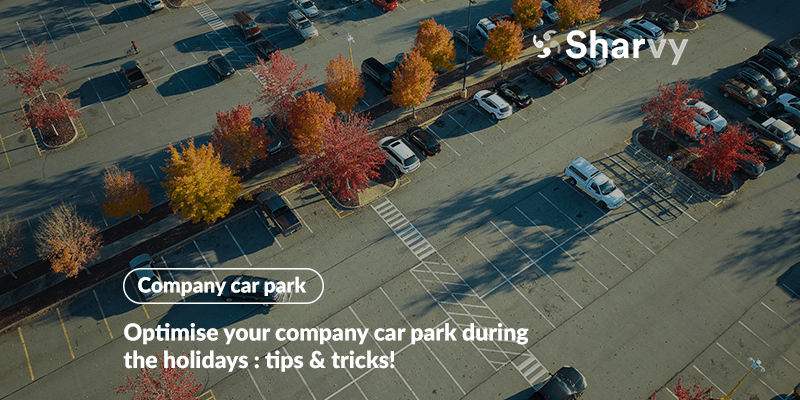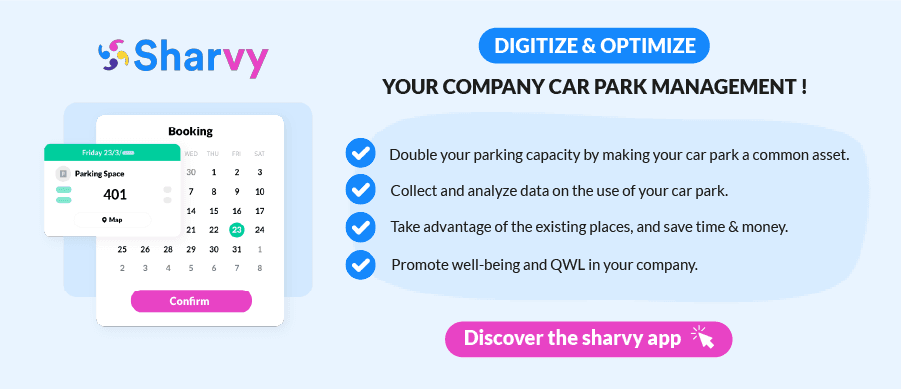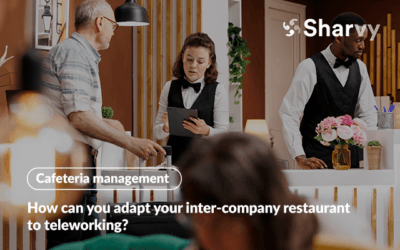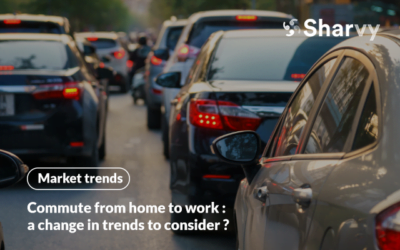Every year, the holiday period disrupts the usual rhythm of companies : fewer staff, slower activity and (almost) empty car parks.
Yet this reality often goes unnoticed. Habits remain unchanged, spaces remain reserved, rules remain fixed, as if the organisation were operating at full capacity.
This discrepancy between actual presence and car park occupancy raises a simple but strategic question : how can such a visible space be so neglected? Because behind these dozens of unoccupied spaces lies a whole vision of organisation, equity and resource management.
What if these off-peak periods were an opportunity to reinvent the way you manage your car park?
In this article, you’ll find practical solutions to make your company car park a real lever for optimisation, serving both your teams and your image.
Why do holidays throw the use of your company car park off balance?
As the summer holidays and the end-of-year festivities approach, something happens again and again: the company car park empties out, but nobody takes advantage of it. At first glance, this may seem like a harmless phenomenon, but in reality it’s a real missed opportunity.
When employees are on holiday, the attendance rate drops considerably, and with it car park occupancy.
In many companies, places are still allocated in a fixed way (quite often), based on seniority & hierarchical status, even if the incumbents are absent for several weeks.
This lack of flexibility in the allocation of spaces leaves a large part of the car park under-utilised.
At the same time, this prevents other employees, service providers and visitors from benefiting from these vacant spaces. This lack of adaptability creates a real waste of space and encourages unequal access to car parks.
By leaving these spaces reserved but unoccupied, the company not only loses efficiency but also its image, as it generates frustration among those who do not have access to a space when they remain empty.
This highlights the importance of rethinking car park management during holiday periods to avoid this imbalance and make more flexible & equitable use of the space available.
How can you make the most of your company car park during the holiday period? 5 tips & tricks!
1. Take stock : analyse usage & identify availability.
The first essential step is to find out what really happens in your car park during the holidays. During the holiday period, many parking spaces are left vacant, but remain automatically reserved (simply because no-one takes the time to check).
The result? Dozens of places remain unoccupied, without ever being made available.
This is where your optimisation leverage begins : identify the employees who are absent, the unused places and the length of leave. A simple in-house survey, an email request or an Excel file may be all you need… in the short term.
But let’s be honest: doing it by hand every year quickly becomes time-consuming, tedious and a source of errors. And once the data has been collected? You still have to process it, manage the requests, allocate the available places manually, and so on.
In short: you spend more time managing exceptions than actually optimising anything! This is where a digital tool comes into its own.
Automate the collection of availabilities, centralise responses, view free spaces in real time, and many other functions! That’s exactly what a car park management solution like Sharvy can do.
2. Digitalise the management of your company car park during (and after) the holiday period.
If you continue to manage your company car park manually during holiday periods, you’re missing out on a real opportunity for optimisation.
Traditional place management (via Excel files, for example) quickly becomes inefficient, time-consuming & a source of confusion, as I said earlier. Every year, it’s the same scenario: you waste precious time managing absences, reallocating places and responding to specific requests.
In the end, it’s wasted energy, with no real return on investment.
But what happens if you do nothing? If you stick to your usual pattern and don’t change your approach? The car park remains empty, even though the spaces are there, available but unused.
Meanwhile, other employees, visitors and service providers have to get by without access to a parking space, leading to frustration and disorganisation. Empty spaces don’t earn any money, and manual management only maintains this inefficiency.
So why not simplify all this with a digital tool?
This is where a digital solution like Sharvy can really make a difference. By centralising all the information in real time, the application can automatically optimise the allocation of places (thanks to an equitable algorithm), anticipate absences and offer great flexibility, without the constraints of traditional methods.
If you’re curious to understand how the Sharvy application works, what it costs & what its benefits are, ask for a demonstration (only 30 minutes is enough)!
3. Reorganise for greater flexibility (even temporarily).
If your company doesn’t yet have a car park management solution, there’s nothing to stop you taking action in the short term, using simple means.
For example, by setting up a temporary sharing system (by rotation, one-off loan or weekly reservation). This can already make a real difference! Employees who don’t usually have access to a seat can benefit from it on a one-off basis.
A simple Excel spreadsheet may be all you need to manage this operation. The most important thing is to structure this file clearly: one column for the parking space numbers, one for the usual holders, another to indicate their dates of absence (and of availability of the space), and finally a column for the employees requesting the space, with manual validation or in chronological order for example.
Admittedly, it’s not an ideal or permanent solution, but it’s a good way of testing uses, initiating a sharing approach and giving teams a sense of responsibility.
That said, this manual organisation quickly shows its limitations. It takes time and rigour, and is prone to errors such as oversights, duplications and misunderstandings. Without an overview in real time, it’s difficult to anticipate or optimise anything.
And without transparent rules, the system can generate frustration. Despite this, it’s a good way to prepare for the transition to a more fluid, automated and equitable management system thanks to a digital solution.
4. Reserve a few places for unforeseen needs.
Even during holiday periods, when there is less traffic, not everything can be planned. A teleworking colleague who decides to come into the office on an exceptional basis, a client who drops in unannounced, an urgent meeting, a maintenance operation…
The unexpected continues to punctuate the life of your company!
That’s why it’s a good idea to deliberately reserve a few unallocated « » buffer pitches. This small margin of flexibility allows you to react quickly if you need to, without upsetting the whole organisation.
In this way, you avoid last-minute frustrations, you improve the experience of your staff (and visitors), and you also demonstrate that your organisation knows how to combine rigour and agility.
5. Take advantage of this holiday period to rethink your parking policy for your company car park.
What if the holiday period also became a time for listening and reflection? With a slower pace and less activity, it’s the ideal time to take a step back from the current organisation of the car park and better understand the real needs of your employees.
Why not launch a mobility questionnaire? By asking your teams about how they use the car park, their travel habits and their expectations in terms of facilities (recharging points, cycle parking, access to the car park, etc.), you can collect valuable data to help you adjust your parking policy.
It is also an opportunity to question certain sensitive points: the relevance of allocations, the desired flexibility, or the frustrations experienced during off-peak periods. This type of survey not only enables us to better target the actions to be taken, but also to involve employees in a collective improvement process, at their own pace, far from the usual hustle and bustle.
In short, it’s a time when there’s less pressure, more listening and a great opportunity to align your mobility strategy with actual usage.
In conclusion
Holidays are often synonymous with quiet offices… and empty car parks. But why not make the most of it? These lighter periods are ideal for trying out new ideas, adjusting organisation, or simply sorting out our habits.
Without overhauling the entire operation, small changes can already improve fairness, fluidity and the day-to-day life of your employees.
What if you started to make better use of this downtime this year to bring about smooth changes in your car park management? Click here to find out.
Got a question? Check out these FAQs !
How do you manage any conflicts that may arise around temporarily vacated spaces?
By laying down simple rules from the outset. For example: allocation according to order of request, priority for carpoolers, or weekly rotation. The clearer and more transparent your rules, the less tension there will be. A short internal charter may be enough to set the framework.
Which teams should be involved in reorganising the company car park?
General Services, Human Resources (HR) and the teams responsible for Quality of Life at Work (QWL) are naturally on the front line: they are the ones who manage the space, the logistical requirements and the impact on your employees’ daily lives.
But for the process to be truly effective, it’s just as important to involve your car park’s users. By putting together a small project team, made up of staff from different departments and hierarchical levels, you open the door to concrete feedback, practical ideas and greater acceptance of the changes.
It’s a simple but powerful way of co-constructing a solution tailored to real needs on the ground.
Want to find out more? Check out our latest articles to stay up to date!
How can your inter-company restaurant adapt to teleworking?
Teleworking : how can you manage the number of people using your inter-company restaurant & adapt your offer to new working habits? Focus.
Change management : how to facilitate the adoption of a new tool?
What are the essential steps to facilitate change management in your company ? Our advice and best practices can be found here.
Commute from home to work : a change in trends to consider ?
Commute from home to work : what trends can be observed? What are the risks? How can they be improved? Focus in this article.
Subscribe to our newsletter!
PARKING & WORKPLACE MANAGEMENT SOLUTION
Car park management - Charging points monitoring - Desk booking - Booking by time slots
SUBSCRIBE TO THE NEWSLETTER
Receive the latest Parking & Workplace trends by email once a month.












